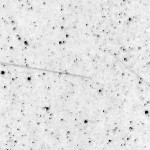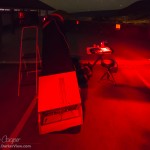A possible meteor shower, a dark. moonless night, the beautiful skies of Mauna Kea… Why not plan for a trip up the mountain? We all hoped that the new meteor shower would produce a show for us. If not, it would be a dark night with a late rising crescent moon. As I would be working the holiday on Monday, I took Friday off, did some chores around the house and packed my gear.

The second bit of kit was Deep Violet, my 18″ telescope. As usual, setting up the big scope quickly gathered a crowd. The line did not dissipate until well after 10pm, a steady flow of visitors hoping to check out the view in the largest telescope present.
The prediction had been for plenty of meteors, up to hundreds per hours. The result was somewhat less than that. We did see a few, but nowhere near a the level of a major meteor shower. The predictions were honest, everyone knew that a poor showing was a possibility, there were just too many unknowns involving this new shower. It is impressive that we managed to predict a new shower at all. This is the first time anyone had realized that a new meteor shower was possible in advance of the event. Reports from across the hemisphere indicated that the shower did materialize, with a rate of perhaps 5-10 ZHR.
I did see two meteors that were probably Camelopardalids, both reasonably bright. A bit of a surprise I saw that many. The line of viewers at the eyepiece of the 18″ was long indeed. Once it was dark enough I set globular clusters like Omega Centauri for the folks at the eyepiece. Later it was M51 and NGC4565, a pair of objects that looked pretty good in the big mirror.

It was great talking to all my friends who made it up. Truth be told, I did more socializing than observing during the first half of the night. I lent Violet to a fellow amateur astronomer from Canada for a while, allowing him to check out some southern objects unreachable from his home latitude.
B93 A very dark void in the northern margin of the M24 star cloud, about 20′ x 15′ larger north to south, very few stars (<12) punctuate the darkest region, edges indistinct with a gradual darkening, a contrast to the surrounding rich starfield of M24, B92 is seen 20' west B92Large, about 20′ in diameter, les dark and less defined compared to the nearby B93 just 20′ east, quite a few stars sprinkled across an area devoid of the glow of faint stars that surrounds
NGC6603 A rich star cluster about 5′ in diameter, resolved, notably richer than the already rich starfields of M24, about 20′ southeast of B93, a notable bar of stars runs northwest to southeast across the center of the cluster
In the wee hours of the morning I did get some observing done, wandering through eastern Sagittarius. I toured past a few dark nebulae, globular and open clusters. The skies remained perfect all night long. At 2:40 the Moon rose, a pretty 20% crescent. Following the Moon a bright Venus rose, punctuating a pretty dawn.
Trumpler 33A sparse object about 10′ in diameter, a half dozen brighter stars (mag. 9-10) arranged in an arc running north to south on the west side of the cluster, a couple dozen dim members fill the area, a bright star at the center (HD 169274 V=7.56) is notably orange
M22 Big, beautiful, 20′ in diameter, fully resolved, round, core not notably condensed, a stunning mass of stars filling much of the field of view
M25 Large, bright, a sparse cluster with stars spread across 20′ of sky
NGC6717A faint globular cluster almost lost in the glare of the 5th magnitude yellow star Nu2 Sgr (HD 175190 V=4.98), about 5′ in diameter, not resolved

As usual I was the only one left when the first glow of dawn appeared over the shoulder of the mountain. Breakdown went smoothly, allowing me pretty views of the Moon and Venus above a golden dawn as I drove down the mountain. I arrived home in Waikoloa just as the first rays of sunlight crept over the landscape. It may have been a letdown for meteors, but it was a beautiful night under the stars.


I had wanted to look through Deep Violet many times, but the line was too long! I had also wanted to do some imaging and try out the Bahtinov, but my eyes were already too dried out. I don’t know how you can last until dawn. Driving down the hill, I spied a deep orange glow on the left over the forest, and thought that it was from Halemaumau, and I was seeing it from an angle. As I got lower it turned out to be the rising orange crescent moon, with a color just like a total eclipse. I was tired, and thought that by the time I set up I would have missed it. But it remained pumpkin orange until I was just above Hilo. I have a feeling that you would have stopped.
Thanks for all your help that night with the intervalometer, and for the loan of your Losmandy plate. I will order one. I messed up somehow with the Milky Way pictures. I was zooming in and out trying to get different perspectives, but ended up with oof images with anything other than the widest focal lengths. I should have checked…perhaps infinity focus shifted? Try again!
Great post over all!!The trick raymond is to practice with the lens focus and then etch the focus point on your lens or do a mask trial and figure out how to lock the focus on your lens. Duck tape?
Andrew or chris can drill you a hole and u put a setscrew in it?
Ha! LOL.
Aloha
maybe finally see younext month Andrew